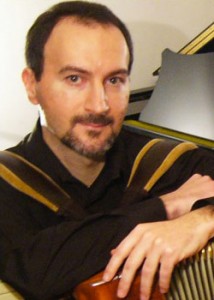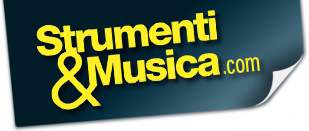 Alessandro Mugnoz has achieved diplomas Choral music and choir direction (Conservatory “Martini” in Bologna) and Accordion (Conservatory “Rossini” in Pesaro).
Alessandro Mugnoz has achieved diplomas Choral music and choir direction (Conservatory “Martini” in Bologna) and Accordion (Conservatory “Rossini” in Pesaro).
Since the early ’80s he performed in concerts, as an accordion soloist and in chamber groups: monostrumentali (in particular: I. accordion Quartet “A.Volpi”) and then with other instruments: strings, clarinet, piano. He has made several didactic works and works for solo instrument and for various complexes.
It is active in the field of “Electronic Music” (in particular Midi music), combining and integrating the acoustic timbres of the reed accordion with new electronic sounds, in a continuous research and testing of various manipulations (and “suggestions”) of the sound. In recent years he is dedicating himself to chamber music for accordion and similar instruments (free reed) of the XIX century, discovering the works of authors known and unknown, taking care of reviewing and proposing performing in concert (especially in a duo with the pianist Claudia Menghi).
Recently he wrote (with his father Edgardo) an innovative “Basic method” for diatonic accordion, published by Editions Ars Spoletum.
He is the President of the New CDMI (Italian Music Learning Center).
Let’s talk about your beginnings. When did you start studying the accordion and why.
My first approaches to the music from the late ’60s, to the 6-7 years I had the gift of a small accordion, which is actually not initially impressed me too – remember that at that time also played the “clavietta” and the first “electric pianos”, then over time I became a passionate amateur of the accordion… The reason for this instrument is obvious: my father was (and still is) an accordionist – teacher, as well as sculptor, and he was my first teacher and I owe to him if then the music has become my profession.
What is the project you are working at the moment?
Currently, in addition to continuing engagement with the teaching, I’m curating a project very dear to me: the realization of a book entitled “The forerunners of contemporary accordion. A repertoire to be rediscovered”. This work, sponsored by the New CDMI and funded by the City of Castelfidardo (for the 150th anniversary of the Italian fisarm), will be released in the coming months and I think it may represent a significant first step aims to fill a void in the treatises of the instrument. Furthermore, in addition, I am organizing Seminars and Workshops, always inherent in the topic “nineteenth-century ancestors of the accordion” and we have already begun in September, with a successful seminar – held together with his colleague C. Rojac – held in Castelfidardo. Soon, in March, I will hold another seminar instead at the “Rossini” in Pesaro.
On the cultural level, the accordion is different from other instruments. It is both a tool cultured and popular, niche and very popular, ancient and modern. What observations can we do about these issues.
The question is very relevant and I would say “challenging”… In fact, everything stems from the fact that one should speak of “accordion” (plural), not only for the wide variety of models, but also for its variety of uses, or of musical genres and repertoires involving these instruments. A little as for the guitar (and maybe even more so) we can consider the term “accordion” as a surname, indicative of a “family”… then is the proper name to define the person, whether he is a parent, brother or another family member. So it will always be necessary to indicate both words (name) to specify the instrument to which we refer, together with (often) to the repertoire of reference. For example it is called “diatonic” or “chromatic” and “keyboard accordion” or “buttons accordion”, but also “ectronic” (or digital) and “free bass”… Often then you have to add an additional term or indication to better specify the type of instrument, so you can talk about free bass “minor thirds” or to “fifth” of accordion with buttons “C-griff” or “B- griff” (depending on the arrangement of notes), and thus there is a link to certain regions or countries. Not to mention, again as an example, of diatonic system “Irish” or “tex -mex” or “melodeon”… indicative of many musical genres.
In any case we can say that even considering only the so-called “classical accordion” (that is equipped with a “converter”, MII – MIII ) – which, in my opinion, combines in itself the main features of the various models mentioned above – it is a very versatile tool; objectively one of the most complete, including acoustic instruments, therefore able to approach basically any repertoire, from early music to a variety of contemporary music… Probably this “eclecticism” is also favored by the relative “youth” of the unitonic instrument, which is found a bit to stand “on the shoulders of giants” (such as an organ or piano), and then to assume a certain “open-mindedness” which then allows you to move with ease in a variety of musical situations, even for the fact that it could not have (yet) own a large repertoire …
The complexity and the joints of the accordion require a search also in teaching, in the development of dynamic and innovative methods?
This is also a good question that, in many respects, it binds to the previous year. Being the accordion (at least those “chromatic” or unitoniche) relatively young, very versatile and comprehensive tool from technical point of view and… organological these characteristics should stimulate a good deal of awareness, and I would say “responsibility” on the part of all operators the world accordion. Starting with the builders, which should not be satisfied with the good results already achieved, but seek diligently to improve their acoustic instruments, then of course the teachers, who also should not settle for the existing didactic material – although quite accomplished in part – but, without denying the past, work for new pedagogical proposals that they keep pace with the times, that is, with the stylistic evolution of musical genres also alternative, without focusing too much or “fossilized” exclusively on one topic (either “classic” or “popular” )! This is especially true as regards the years of the student’s education.
In particular I remember, with my father (Edgardo), I published in 2010 a “Basic method for diatonic accordion” – for editions Ars Spoletium – which goes in the direction above. In addition, with colleagues in the New C.D.M.I. and as President of the association, I have collaborated in the development and/or updating of various educational programs, including one for “accordion (low standard)” and “diatonic”. Are being designed for those “Accordion Variety” and “free bass accordion”.
Can you talk about your interest in the chamber music repertoire for accordion of the nineteenth century?
Referring back a bit to the second answer, my interest in the nineteenth-century repertoire goes back about 15 years ago, when I began a search of the tools forerunners of today’s “classic” accordion: physharmonica, diatonic accordion, concertina, bandoneon, harmonium, harmoniflute, etc. I believe that the “historical memory” represents a fundamental value for our musical identity, but first I would say cultural and, more generally, social. A value to be transmitted then, with determination, to new generations, as one of the cornerstones of the teaching and not only (together with the parallel innovative aspect mentioned above). So you need to know (well) then who are we to know where to go… So there is a whole repertoire, from the end of “classicism”, runs through the “romance” and “late Romantic”, linking perfectly with the accordion before production start twentieth century. These nineteenth-century music, the authors also prestigious, they may certainly enrich the teaching repertoire, chamber and concert accordionist contemporary… it is just “look for”, perhaps review them for the current tools, and then make them live again in the many musical opportunities are possible today.
Tell us about your experience in the field of electronic music.
My first experiences in electronic music dates back to the late 70s… when I accosted the study of the electronic organ accordion, at the time rather used, even didactically (Schools Yamaha, CDMI, etc.). Later I became interested also synthesizers and MIDI, then implementing the electronics on one of my accordion, so to speak combining my two passions. With this instrument experienced varied and interesting situations, making dialogue – and amalgamating them – the acoustic timbres of free reed with those, innovative and multi-colored, offered by electronics. Later I became interested more and more in the “computer music”, I was probably one of the first musicians in my region (Marche) to buy a “Atari ST”, then creating different arrangements, both for teaching and in the field of pop and jazz music. In recent years I have a little left such activities to devote to the projects mentioned above.
Questo post è disponibile anche in: Italian

 English
English Italiano
Italiano 





Leave a comment
You must be logged in to post a comment.